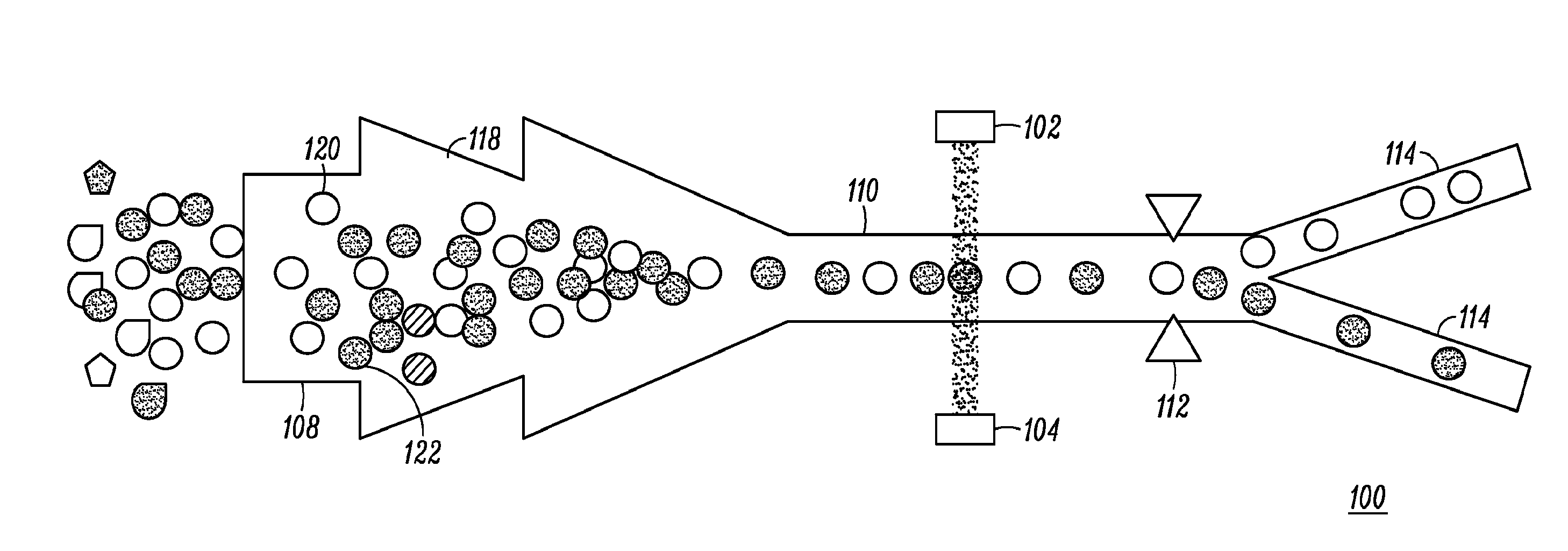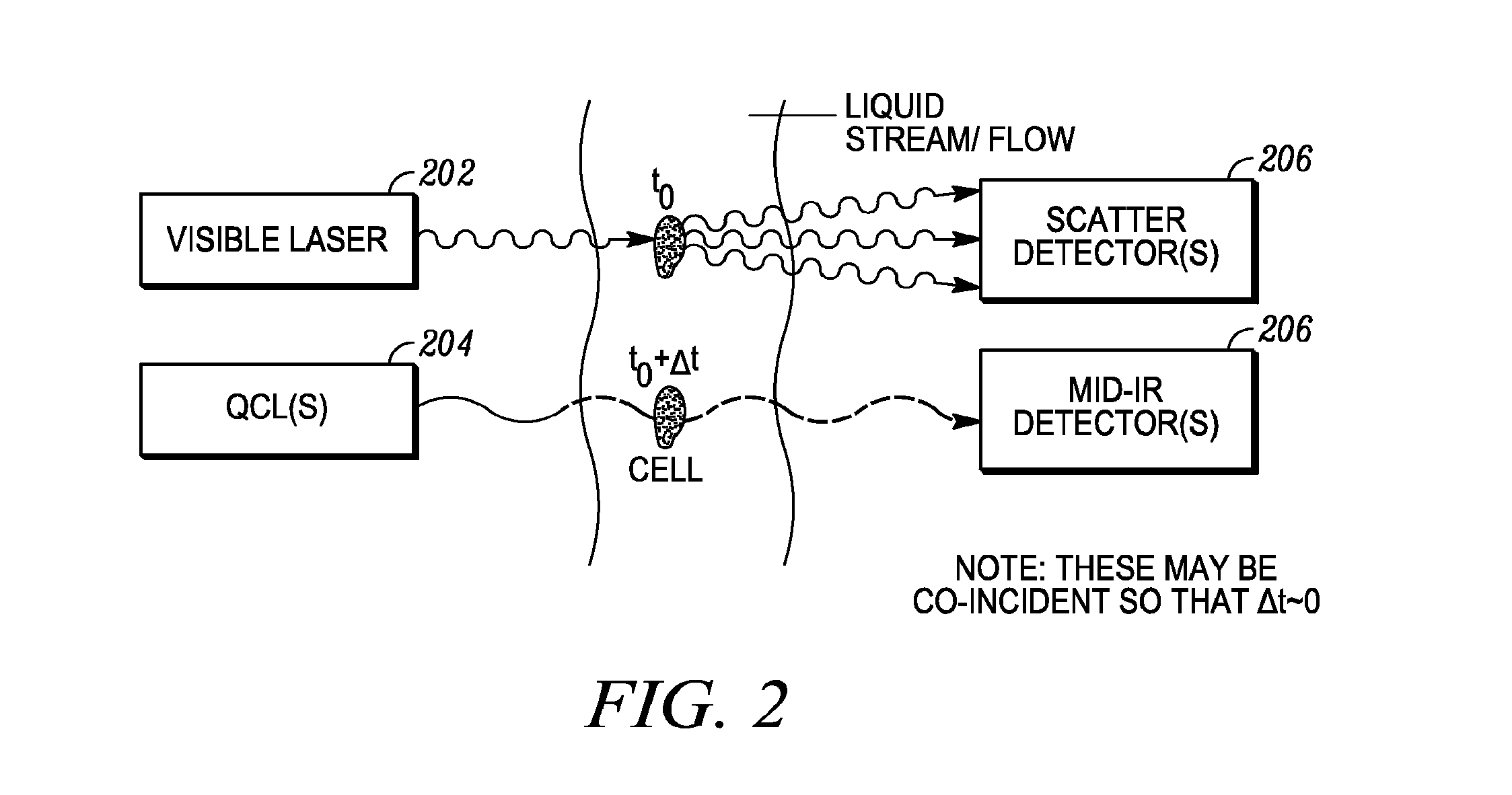There is currently no safe and accurate method for
cell sorting.
There are two major disadvantages to this method applied to certain cells, including low accuracy and safety concerns.
In addition, in
sperm cell sorting, the FACS process has been shown to cause chromosomal damage in
sperm cells as a result of the dyes used, and as a result of
exposure to
high intensity 355 nm
laser light.
However, these chemical markers may damage or alter the function of the target cells, which is particularly disadvantageous for live
cell sorting.
In testing, dyes used as markers for
DNA, for example, have resulted in chromosomal damage.
Further, the intense UV or visible light used to read the level of marker in the cell may damage the cell, in particular,
DNA damage results from
exposure to high-energy UV or visible photons.
Also, because of the wavelengths used in so called
fluorescence activated
cell sorting (FACS) systems, quantitative measurements (rather than yes / no measurements for a particular
antibody) are made very difficult, because both the illuminating
wavelength and the emitted
fluorescence are scattered and absorbed by cellular components.
This means that cell orientation becomes an important factor in accurate measurement, and can dramatically reduce the effectiveness of the
system.
With
Raman spectroscopy, the individual
photon energy is generally lower than that used for fluorescent markers, however, the
net energy absorbed can be very high and unsafe for live cells.
One significant drawback of mid-IR
spectroscopy is the strong absorption by water over much of the “chemical
fingerprint” range.
This has strongly limited the application of
Fourier Transform Infrared Spectroscopy (FTIR) techniques to applications involving liquid (and therefore most live cell applications) where long integration times are allowable—so sufficient light may be gathered to increase
signal-to-
noise ratio and therefore the accuracy of the measurement.
The lack of availability of high-intensity, low etendue sources limit the combination of
optical path lengths and short integration times that may be applied.
In addition, because of the extended nature of the traditional sources used in FTIR, sampling small areas (on the order of the size of a single cell) using apertures further decimates the amount of
optical power available to the
system.
Again, however, the
coupling into the substance of interest is very shallow, typically restricted to microns.
This adds significant complexity to the measurement process, and limits the applications in which particle size, shape, density and biochemical makeup may be characterized accurately.
One of the problems raised in mid-IR microspectroscopy when particles are present is that of scattering.
Since scattering is dependent on both the size of the particle and the
refractive index of the particle relative to the medium, this results in localized “resonant” scattering.
Problems are especially prevalent when the particles or cells being measured have high-index relative to the medium when using mid-IR
spectroscopy such as FTIR where
scattered light can be misinterpreted as absorption, and artifacts in the Fourier-inverted spectrum can result.
This causes additional index mismatch between the medium and cells, dramatically raising scattering efficiency and angles; 2) Measurement of absorption peaks at high wavenumbers (short wavelengths) where scattering efficiency is higher; 3) Insufficient capture angle on the instrument, where typically the capture angle on these instruments is identical to the input angle, not allowing for light scattered outside of the delivered IR
beam angle; and 4) Transflection or other surface-based measurements.
These configurations may lead to additional artifacts in conjunction with
Mie scattering effects.
It is not possible to determine
chemical composition at these wavelengths, and therefore, to eliminate this factor which affects scattering pattern and therefore volume estimate.
However, one of the challenges of mid-IR
spectroscopy on particles or cells, particularly where high
throughput is required, is getting sufficient contrast as a particle passes through the measurement volume.
For cells suspended in water, the significant absorption bands associated with water in the mid-IR
pose a challenge.
Additionally, the requirement for an
electrically conductive medium places limits on the materials and particles that may be measured with a resistance-based method such as the Coulter Counter.
While this method is novel and potentially highly accurate, it is highly complex (requires significant difficult fabrication, calibration, compensation) and potentially suffers from low
throughput (flow rates must be kept low to provide an accurate measurement and prevent rapid clogging).
Both of the aforementioned methods (Coulter Counter and
cantilever “scale”) also have the
disadvantage that they may be difficult to integrate with other measurement techniques.
Wherein the
relative phase delay between the two beams is created so the beams destructively interfere when they are recombined.
An adjustable phase
delay apparatus on one of the beams is configured to result in destructive interference between the two beams when the sample is comprised of medium without particles.
 Login to View More
Login to View More  Login to View More
Login to View More 


